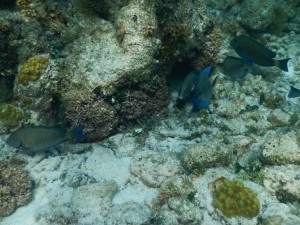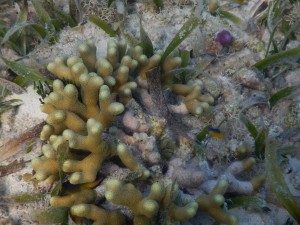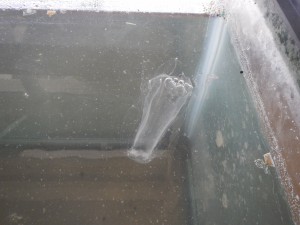The day is done. I think that the entire group is in disbelief. It’s hard to imagine not living 24/7 with these thirteen people always around. I, really all of us, have become accustomed to our daily routine of rising early and exploring the different natural features of Belize. If it were up to me, we would explore the other major ecosystems of this country (the Maya Mountains and the savannah). I would also be interested to see how Belize City differs from Houston, Philadelphia, or other international cities.
Anyway, today was mostly spent quantifying biodiversity on the back reef near to the research station. This means that we spent the morning wading around the shallow area searching for any organism we could find. I was particularly proud of myself for finding a cute, small snail that crawled all of the way up my dive skin. I was less excited about the dead fish that Randy stuffed in my dive skin. We found a least five different types of green algae, a sea cucumber, a sponge, lots of brown algae, red algae, a French grunt, a yellowtail damselfish, a goby, a couple molluscs, and a couple of jellies.
On another note, I did not see that many examples of my taxonomic group. On the brief times that the water was deep enough for us to snorkel, I saw (shocker) a lot of sea fans (Gorgonia ventalina). In the end, I think that I have seen all of the soft coral on the Glover’s field guide. I wonder what the relatively high abundance of soft corals means for the hard corals, in terms of reef accretion. Anyway, this trip has opened up numerous future research topics. I hope to learn more about them in the upcoming semester at Rice.
Tag Archives: 2016
Lionfish, Day 14
So today we went to the back reef for a very brief period in order to essentially say goodbye. I felt very sad swimming through the shallow patchy reef, realizing I won’t be on a reef until next year. I said goodbye to the stony corals. But as a last gift, I got to see four amazingly large queen triggerfish, and then I was content.
We traipsed through the shallow flats for a spell to find some interesting critters and organisms from our taxon assignments. Some of my favorite critters were the large hermit crab, the mantis shrimp, blue crab, and sargassum algae.
Then came the lion fish dissection. We caught a total of four lionfish. We weighed the lionfish, measured total length and standard length, had the spines cut off by Adrienne, measured the gape width and height, and then dissected the fish. Specifically, we wanted to look at stomach contents, weigh the fatty parts of the fish, and then sex the fish. My group had trouble finding the gonads, so we couldn’t sex the fish.
After that, we went to Southwester Caye for a fun excursion and then packed up and headed to bed.

Last full day
The last night of our trip came too quickly. This atoll we came to so many days ago still doesn’t feel like a real place to me. It’s like this has all been a never-ending movie. Despite that it will end tomorrow. We will pull into Rice tomorrow night and it will all be over.
Enough sentimentality though, let me recap the day. Morning was spent returning to a very special spot on the back reef to collect specimens for a final display of marine organisms. Algae, crustaceans, and even box jellies were all represented in this summary of our taxa. I found a sponge in this area of the reef but was unable to identify it. It was soft, green, and encrusting but it didn’t look like any of the sponges from the Glover’s ID guide.
After the last of the lecture topics, we analyzed the data collected yesterday on percent cover of live coral on colonies measured last year in order to basically start a longitudinal study. This would be a great opportunity to look at coral colonies over the years and how they change in shape and size.
The afternoon was spent dissecting lionfish we had caught this week at the various sites we visited on the reef. Sam and I had the littlest guy, which was too immature to determine its sex. But we did open up its stomach and reveal a gross fish mush. I don’t know. It was gross but in the end we got to use the filets to make ceviche so it was all worth it.
I’m trying to make the most of these last dozen or so hours here at Glover’s. I think exploring the island a little more is in order. Sleep will certainly not come easily tonight despite the work we’ve been putting in all day. I can’t let this experience slip by too quickly.
Sunrise + Lionfish + Tourist Tiki
Hi everyone! The sunrise was absolutely beautiful today. The 4:45 am wake-up was definitely worth seeing the sun peeking through the clouds on one side of the island and a perfect rainbow in the sky on the other. I’m going to try and watch it again tomorrow before we leave. 🙂


This morning was spent in the back reef collecting as much biodiversity as we would find and analyzing the health of some corals that had been measured last year to see if the number of live colonies had increased. While we were at the back reef, some exciting things happened. I identified both some live red heart urchins (Meoma ventricosa) and their empty tests in the sand among the seagrass as well as a few more donkey dung sea cucumbers (Holothuria mexicana). I also saw a chocolate chip sea cucumber (Isostichopus badionotus); all of these sea cucumbers were also in patches of sand between coral colonies. The other news I have to share from the patch reef was my sting from an anemone, which burned like fire for a while but now has reduced to a dull throb (tip from the locals: soak stings in vinegar).

After lunch, we dissected some lionfish to examine their stomach contents and watched one of our marine safety officers, Herbie, make ceviche out of it. We then took a boat to a tourist island with an adorable tiki hut on the water. All in all, it was a really great day.


Day 14?!
I can’t believe that this trip is already coming to an end. It seems like just yesterday we were 16 people crammed into a 14 passenger van, filled with excitement and ready to begin our adventure.
We spent today wrapping up a variety of projects from the week. In the morning, we went out onto the fore reef to collect samples to take back to the wet lab. We found many types of algae, crustaceans, mollusks, and other species. As far as red algae, I saw tubular thicket algae, Galaxura rugosa, and Amphiroa fragilissima. I also found crustose coralline algae growing on the back of a hermit crab. It looks like I’m not going to find a tunicate on this trip.
In the afternoon we dissected the lionfish we caught earlier in the week. Ours was a male with a surprisingly large fish in its stomach. After the dissection, we made lionfish ceviche.
This evening we visited a resort on a nearby island. It was really interesting to hear the stories of other visitors on the island, and we got to watch a spectacular sunset from the dock.
So Long, Glover’s

Our time in Belize has nearly run its course, and while I’m excited at the prospect of a hot shower, I can’t believe how quickly two weeks have passed. For our final day at Glover’s Reef,
we set out to find as much diversity as possible in the back reef close to the shore of Middle Caye. In my final snorkel here, I found a
huge number of herbivorous fish. Ocean surgeonfish (Acanthurus bahianus) and doctorfish (Acanthurus chirurgus) swam right past me in pairs and groups, and I found an abundance of cocoa damselfish (Stegastes variabilis) in between the corals. I also saw several French angelfish (Pomacanthus paru), a large black and yellow fish that feeds on algae, as well as some invertebrates.

We also collected a number of species from the shallow seagrass beds by the shoreline and sorted them by taxonomic group. Using just nets, we were able to catch two yellowtail damselfish (Chrysiptera parasema) and another fish that I believe was a species of goby. We ended the morning by presenting a colorful array of macroalgae, echinoderms, jellyfish, and mollusks.
The afternoon’s activity was our long-awaited lionfish dissection. We were only able to capture four specimens of the invasive species, but each one was dismembered and analyzed by its stomach contents. Hopefully, the more we can learn about the lionfish, the better we can manage its invasion of the Caribbean.
For the perfect ending to our last day on the reef, we visited Southwest Caye, another island inside of the atoll. From the comfort of the dock, I watched the sun set on my Belizean adventure (at least for the time being).
Day 14: Sometimes the Things You Most Wish for are not to be Touched
Just when I thought my efforts were futile in finding the elusive jellyfish and ctenophores around Glovers, this afternoon my colleagues managed to find for me six box jellyfish wash up on shore! And as a bonus, the whole group was preparing for a taxon group exhibition where we have specimens to display and explain to each other. I was able to harvest the 6 jellyfish, being wary to not touch the notoriously venomous tentacles. In most cases, handling a box jellyfish by the head (bell) is harmless, though some species are known to contain stinging cells on their head, but those variants only occur in parts of Australia.
The species of box jellyfish found was Alatina alata, the same as the jellyfish first found. Their stings are known to cause something called Irukandji syndrome, a life threatening condition that manifests in symptoms like headache, body pains, vomiting, a sense of impending doom, and hypertension. Pretty scary. A scary fact about jellyfishes is that even though most of the specimens were dead they could still sting. During my presentation, a large sign hung over me saying, DO NOT TOUCH! I hope I didn’t worry my instructors too much!

Even though these guys were scary to handle, I had so much fun looking at these dangerous creatures close up. I was able to show my class the tiny complex eyespots embedded in the jellyfish. One question I have is why these 6 jellyfish all beached at Glovers at the same time? Were they traveling as a group or was it just coincident beaching? If they were traveling as a group, are jellyfish capable of social behaviors? Questions abound, but this has definitely been an exciting turnaround in my jellyfish adventures.
One thing I should point out, box jellyfish aren’t in the same class as “true” jellyfish. They have different complexities of their nervous systems in spite of sharing a similar body plan. Let’s see if I can find anymore jellyfishes on our trip to the mangroves this next morning!
Other than the amazing box jellyfish beaching, we dissected some lionfish that we captured a day before to analyze their health and stomach contents. Lionfish are invasive species and eat basically anything, so our info may shed light into how these guys are doing in the Caribbean. Once we finished dissection, we made ceviche out of them! Delicious science and an interesting way to end our last full day at Glover’s.
Day 14: It’s the final countdown
Today was a very busy day. This morning we went out to the back reef again, this time while collecting algae and other things that were safe to bring back to the wet lab. I saw my same anemones I have been seeing (Giant Caribbean and Sun anemones). I did see something that was sort of new though. I think I saw a purple morph of the giant Caribbean anemone. We ended up collecting a sea cucumber, razor clam, crabs, so much red, green, and brown algae, and egg pods that hatched into hundreds of baby shrimp after we collected them.
The other happen stance with my groups today was that a student accidentally put her hand down on an anemone and it stung her pretty decently. Luckily, no one got stung by the box jelly fish (Carybdea alota) that were found today.
We also dissected the lionfish (Pterois volitans) that had been caught previously. The lionfish I worked on was a mature male who had recently consumed a 4-5 cm fish. It had begun to digest, but we could tell that the fish had had yellow scales.
After some relaxation, we will still need to pack up and prepare for tomorrow. We may be getting back tomorrow, but we are not done yet.
Day 14 Already??
I can’t believe that today is our last full day in Belize. While I am excited to take a warm shower and have clean clothes, I am also incredibly sad that this amazing experience is coming to an end.
Today’s activities began with a snorkel in the sea grass beds and back reef on the left side of the island. Even before the swim started, I saw two species of piscivorous fish at the dock: a small nurse shark swimming about, and a school of needlefish. Once on the back reef, I also saw French grunt, bluestriped grunt, squirrelfish, and a very cool houndfish that was about two feet long.

During this morning snorkel, we also collected a bunch of samples of different organisms in order to be able to look at certain species more closely. The only piscivorous fish collected was a poor French grunt that had accidentally been speared during an attempt to catch an invasive lionfish.
After analyzing some coral monitoring data from yesterday, we got to dissect lionfish! My group’s lionfish was quite small, but still cool to look at. The fish are being made into ceviche as I write this!
We ended the day with a visit to another island of Glover’s atoll, Southwest Caye. It’s amazing how little of this amazing environment we’ve been able to see, even with a whole week of exploring. Guess we have to come back!
Traveling to Glover’s, Day 9
I drank freshly brewed coffee for the first time this morning since leaving Houston and it was amazing. Never underestimate the power of real coffee. (Instant was very nice to have in the forest and I was happy we had it, but the real deal is pretty sweet). We headed to the zoo this morning for a bit. Charlie, the scarlet macaw, spoke to me! He said “hello” three times and only talked to me. I saw the spider monkeys and howler monkeys and then we had to leave. Our van was late again, but only by 15 minutes this time instead of 5 hours.
We drove into Belize City, had lunch, and then headed out to Glover’s on the boat. It took about three hours and I am so happy to say I did not get seasick. We quickly put on our snorkel gear and headed out to a small patch reef that was close to the dock. I saw so many stony corals: Orbicella faveolata, Orbicella annularis, Pseudodiploria strigosa, Pseudodiploria labrynthiformis, Porites astreoides, and Porites porites. I saw many fish as well, like the Threespot damselfish and blue chromis. Afterwards we had dinner and then had a few lectures.
There are hermit crabs and land crabs everywhere! The sand flies are horrible and leave these weird markings on my skin. But falling asleep to the sound of the waves is great. Check back in tomorrow!





